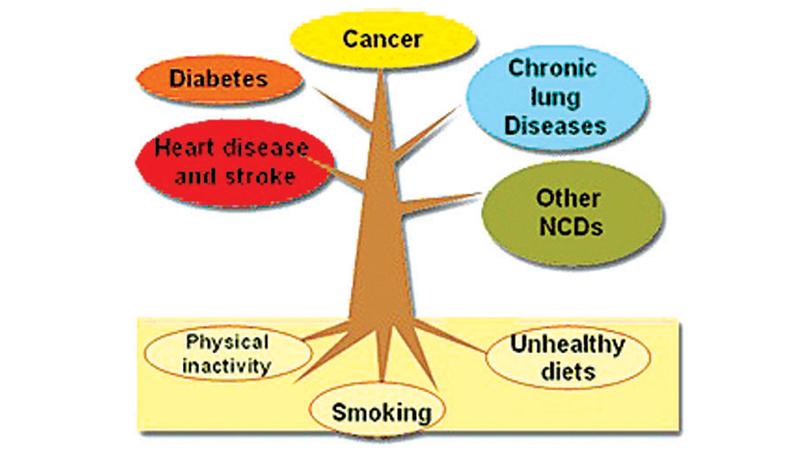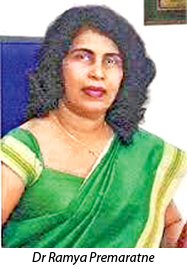
Non Communicable Diseases (NCD) have boomed in recent years and the strong possibility of an NCD epidemic in Sri Lanka looms menacingly as non infectious diseases such as diabetes, heart problems, hypertension, stroke, cancer, kidney failure, are beginning to overtake communicable diseases.
Health officials blame this new trend on unhealthy lifestyle changes, and say that the root cause is over consumption of foods high in sugar content, and the use of salt in our daily meals which far exceed the recommended levels given by the World Health Organisation.
 To help them exercise self control and raise more consciousness about heathier options, the Health Ministry recently made it mandatory for all food products to carry labels resembling the Traffic Code system, indicating the levels of sugar and salt along with other ingredients they contain.
To help them exercise self control and raise more consciousness about heathier options, the Health Ministry recently made it mandatory for all food products to carry labels resembling the Traffic Code system, indicating the levels of sugar and salt along with other ingredients they contain.
Health Ministry Officer Dr Ramya Premaratne tells the Sunday Observer why reading the labels of all foods with sugar content is important for our health.
Excerpts …
Q. The Government recently decided to have a traffic lights system for food as well and made labelling a must. In terms of our general health is this a step in the right direction?
A. The occurrence of non communicable diseases ( NCDs) among Lankans is rapidly increasing due to high sugar levels. The latest data has shown that more than 40 percent of people are suffering from diabetes or are prediabetic, while even more disturbing is that more than 13 percent of children, some below 12 years are now being diagnosed as pre diabetics. It is to prevent the spread of non communicable diseases that the Ministry of Health has announced a ‘Traffic Lights Colour Coding System.’
Q. Explain what this new coding system is for our readers’ benefit.
A. The system is a guideline for consumers when buying any food product containing sugar. It gives them options, and helps them to decide whether to buy such products which may harm their health. There are three colours that each product will show to indicate the level of sugar, which are similar to what you see in our traffic lights: red, amber and green. If the colour on the product shows red it contains a high sugar level, amber indicates medium sugar level and green signifies low sugar which is the healthiest choice. The aim is to raise awareness among the public to make healthy choices.
Q. Does this include readymade sugary drinks now sold in bottles and packets in food outlets?
A. Yes.
Q. A research study in France has just shown there was not only a link to NCDs like obesity and diabetes by consuming these drinks, but a cancer link as well. Your comments?
A. There is no strong evidence that directly links sugar to increased cancer risk, but there is an indirect link.
All cells in our body, including cancer cells need sugar (glucose). We get blood sugar from foods containing carbohydrates, vegetables, fruits, whole grains and low-fat dairy sources. Some glucose is produced within our bodies from protein. But eating a lot of high-sugar foods may mean more calories than you need, which leads to excess weight and body fat. It is excess body fat that increases the risk of many common cancers.
Being overweight or obese is clearly linked with an increased risk of many types of cancers. Mainly, breast (in women past menopause), colon and rectum, endometrium (lining of the uterus), esophagus, kidney and pancreas.
Q. Obesity is a growing epidemic in our country as well according to the WHO, due to lifestyle changes and eating habits. Do you agree?
A. Overweight and obesity present an increased risk to health and are major risk factors for many non-communicable diseases (NCDs) including type-2 diabetes (T2DM), cardiovascular disease (CVD), chronic obstructive pulmonary disease (COPD), some types of cancer, musculoskeletal disorders.
In most people, obesity is caused by eating too much and moving too little. If you consume high amounts of energy from your diet but do not burn off the energy through exercise and physical activity, the extra energy will be turned into fat. Our modern lifestyles are also causing more people to be obese.
Q. Are women more vulnerable?
A. The prevalence of overweight and obesity among men and women varies within and between countries and, overall, more women are obese than men.
Q. What are the common health consequences of overweight and obesity?
A. Raised BMI is a major risk factor for noncommunicable diseases such as: cardiovascular diseases (mainly heart disease and stroke), which were the leading cause of death in 2012, diabetes, musculoskeletal disorders (especially osteoarthritis – a highly disabling degenerative disease of the joints, some cancers, including endometrial, breast, ovarian, prostate, liver, gallbladder, kidney, and colon.
For adults, WHO defines overweight and obesity as follows: Overweight is a BMI greater than or equal to 25
Obesity is a BMI greater than or equal to 30.
Q. What about artificial sweeteners in readymade drinks and childhood obesity?
A. Childhood obesity is associated with numerous unfavourable consequences including type 2 diabetes, non-alcoholic fatty liver disease, hypertension and psychosocial problems, and often results in obesity during adulthood. Consumption of added sugars is positively associated with higher energy intakes, and is thought to be a significant contributor to the rapid rise in obesity. Artificially sweetened beverages are providing the desired sweetness and palatability in various foods, including yogurts, puddings, ice cream, etc
Q. What is the Health Ministry’s role in averting the causes of obesity, diabetes and NCDs ?
A.The Health Ministry’s Food Control Unit has issued circulars to all Medical Officers of Health and Public Health Inspectors (PHIs) to conduct programs to create awareness among the people and small-scale sweet and snack manufacturers.
The National Multisectoral Action Plan has been imposed for Prevention and Control of Non-communicable diseases for the period 2016- 2020 in collaboration with the relevant units in the health sector and professional colleges along with the support of the World Health Organization and other stakeholders.
The Goal is to:
- Raise the priority to prevent and control NCDs.
- Strengthen national capacity and partnerships to prevent and control NCDs.
- Reduce risk factors for NCDs
- Strengthen and orient health systems to address prevention and control of NCDs
- Promote and support national capacity for high-quality research and development for the prevention and control of NCDs
- Monitor and evaluate the progress in prevention and control of NCDs
Q. Your message to the public on eating habits
A. Around 70 per cent of the salt intake of an average person is from home-made food, 10 per cent from natural food and 20 per cent from processed food.
It is important to reduce the amount of salt used at home gradually, so that the family will get used to it. It is better to avoid adding salt to rice while cooking.
Fried snacks and chips, processed fast food, salted dried fish, soup cubes, pickle, sausages, cheese, marmite, are some of the items that include high sodium. Carbonated beverages, sweets both locally-made and imported, cakes, doughnuts, energy drinks, fruit juices with high amount of added sugar, and cream biscuits contain high sugar content.
Also, do not skip breakfast. You could miss out on essential nutrients and may end up snacking more throughout the day because you feel hungry.
Having regular meals at regular times during the day helps burn calories at a faster rate. Eat plenty of fruit and vegetables.
They are low in calories and fat, and high in fibre. They also contain plenty of vitamins and minerals.Get more active. It is key to losing weight, as well as providing numerous health benefits. Exercise can help burn off the excess calories that you can’t cut through diet alone. Drink plenty of water.
People sometimes confuse thirst with hunger. You can end up consuming extra calories when a glass of water is really what you need.
Eat high-fibre foods which help you to feel full, and is perfect for losing weight. Fibre is only found in food from plants, such as fruit and vegetable, oats, wholegrain bread, brown rice, beans and peas.
Read food labels. Knowing how to read food labels can help you choose healthier options.
